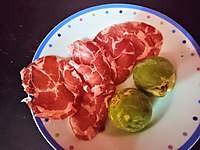Capocollo
Capocollo[1](Italian:[kapoˈkɔllo])[2]orcoppa(Italian:[ˈkɔppa])[3]is anItalianandFrench(Corsica)porkcold cut(salume) made from thedry-curedmuscle running from the neck to the fourth or fifth rib of the pork shoulder or neck. It is a whole-musclesalume,dry cured, and typically sliced very thinly. It is similar to the more widely known curedhamorprosciutto,because they are both pork-derived cold cuts used in similar dishes. It is not brined as ham typically is.
Etymology
[edit]This cut is typically calledcapocolloorcoppain much of Italy, Corsica, and southern Switzerland (Ticinoand theGrisons).[4]This name is a compound of the wordscapo('head') andcollo('neck'). Regional terms includecapicollo(CampaniaandCalabria) andcapicollu(Corsica).
Outside of Europe, terms includebondiola sandwichorbondiola curadainArgentina,Paraguay,andUruguay,andcapicolaorcapicollain North America.[5]The pronunciationgabagoolhas been used bysome Italian Americans in the New York City areaand elsewhere in the Northeast US, based on theNeapolitan languagewordcapecuollo(IPA/kapəˈkwol.lə/) in working-class strata of 19th- and early 20th-century immigrants.[6]It was notably used in the television seriesThe Sopranos,and its use has become a well-knownstereotype.[7][8][9]
Manufacture and use
[edit]In its production,capocollois first lightly seasoned often with red and sometimeswhite wine,garlic,and a variety ofherbsandspicesthat differs depending on region. The meat is thensalted(and was traditionally massaged), stuffed into anatural casing,and hung for up to six months to cure. Sometimes the exterior is rubbed with hotpaprikabefore being hung and cured.Capocollois essentially the pork counterpart of the air-dried, cured beefbresaola.It is widely available wherever significant Italian communities occur, due to commercially produced varieties. The slow-roasted Piedmontese version is calledcoppa cotta.
Capocollois esteemed for its delicate flavour and tender, fatty texture, and is often more expensive than most othersalumi.In many countries, it is sold as agourmetfood item. It is usually sliced thin for use inantipastior sandwiches such aspaniniandmuffulettas,as well as some traditional Italianpizzas.
Varieties and official status
[edit]Three particular varieties,coppapiacentina,capocollo diCalabriafrom Italy, andCoppa deCorse[10]from France haveprotected designation of originstatus under theCommon Agricultural PolicyofEuropean Unionlaw, which ensures that only products genuinely originating in those regions are allowed in commerce as such.[11][12]
Five additional Italian regions producecapocollo,and are not covered under European law, but are designated asprodotto agroalimentare tradizionale(PAT) by the ItalianMinistry of Agricultural, Food, and Forestry Policies:
- Capocollo dellaBasilicata;[13]
- Capocollo delLazio;[14]
- Capocollo diMartina Franca[15]is a traditionalcapocolloof Apulia. It is smoked with laurel leaves, thyme, almonds, Mediterranean herbs, and pieces of bark ofMacedonian oak(calledfragnoin Italian), a tree typical of southeastern Italy, the Balkans, and Western Turkey. Usually it is served with figs orburrata;
- Capocollo tipico seneseorfinocchiata,fromTuscany;[16]
- Capocollo dell'Umbria.[17]
Outside Europe,capocollowas introduced to Argentina by Italian immigrants, under the namesbondiolaorbondiola curada.
-
A piece ofCoppa Spécialité Corse(Corsica): a balanced quantity of white fat is important for flavour and tenderness.
-
Slices ofcapocollo diMartina Francaserved with figs
See also
[edit]![]() Media related toCoppaat Wikimedia Commons
Media related toCoppaat Wikimedia Commons
References
[edit]- ^Gillian Riley."Capocollo".The Oxford Companion to Italian Food.Oxford University Press, 2007. p. 100.ISBN9780198606178.
- ^Canepari, Luciano."Dizionario di pronuncia italiana online".dipionline.it.Retrieved22 September2019.
- ^Canepari, Luciano."Dizionario di pronuncia italiana online".dipionline.it.Retrieved22 September2019.
- ^"Coppa".Culinary Heritage of Switzerland.Retrieved10 March2023.
- ^Canadian Oxford Dictionary,2nd ed., 2004.
- ^Dan Nosowitz."How Capicola Became Gabagool: The Italian New Jersey Accent, Explained".Atlas Obscura. 5 November 2015. Retrieved 20 September 2016.
- ^Schirripa, Steven R.; Fleming, Charles (2007-04-24).The Goomba Diet: Living Large and Loving It.Crown Publishing Group. p. 126.ISBN9780307353030.
- ^Mosiello, Laura; Reynolds, Susan (2009-02-18).The Portable Italian Mamma: Guilt, Pasta, and When Are You Giving Me Grandchildren?.Simon and Schuster. p. 144.ISBN9781440520396.
- ^Dixler, Hillary (2013-06-20)."Watch James Gandolfini's Food Scenes from The Sopranos".Eater.Retrieved2017-03-02.
- ^"COMMISSION IMPLEMENTING REGULATION (EU)".May 29, 2014.
- ^"Coppa Piacentina DOP".www.academiabarilla.com.Retrieved28 May2015.
- ^"Capocollo di Calabria DOP".www.academiabarilla.com.Academia Barilla.Retrieved28 May2015.
- ^"Elenco delle Schede dei Prodotti Agroalimentari Tipici e Tradizionali della Basilicata"(in Italian).
- ^"Schede prodotti tipici Lazio"(in Italian). Archived fromthe originalon 2007-10-29.Retrieved2015-05-28.
- ^"Il Capocollo di Martina Franca preparato con maiale allevato intorno a Martina".www.pugliaandculture.com(in Italian).Retrieved2018-07-30.
- ^"Elenco prodotti Toscana, con schede"(in Italian). Archived fromthe originalon 2012-11-12.
- ^"Elenco delle Schede dei Prodotti Agroalimentari Tradizionali dell'Umbria"(in Italian). Archived fromthe originalon 2007-08-19.
Further reading
[edit]- Schapira, Christiane (1994).La bonne cuisine corse(in French). Paris: Solar.ISBN2263001778.



